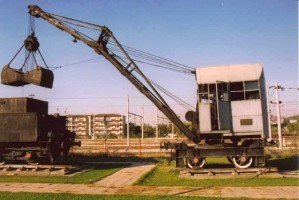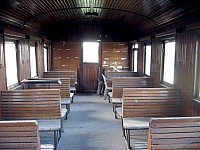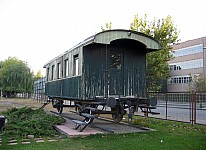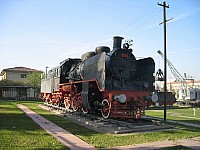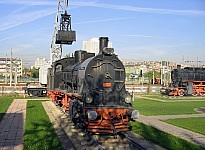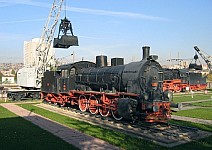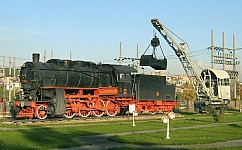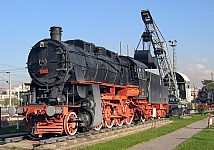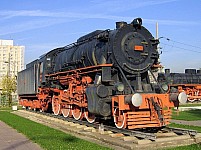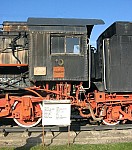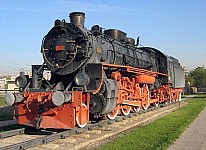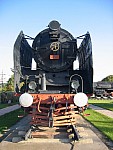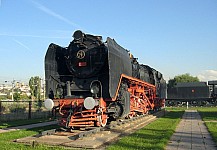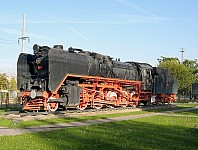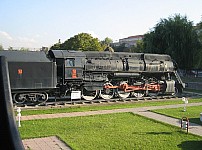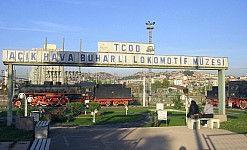<< İstanbul Rahmi M. Koç Museum | Railway Museums in Turkey | Eskişehir Railway museum >>
Ankara Museum
The Ankara railway museum is located in several places around railway station ("Ankara Gar"). Visiting the museum takes you for the grand tour of the station itself! They are presented here in the order of visit. The starting point is the main station entrance of the station building.
Ankara Railway History museum
Access from the station: got to platform one, turn right walk to the next building, the entrance is on the right, at perpendicular angle from the tracks.
Opening hours and cost: the museum is open on weekdays, between 9h00 to 12h00 and 13h00 to 17h00. The entrance is free. Do not hesitate to ring or knock if closed has the guard may have went away a few minutes for a "çay" (Turkish language for teatime).
Collection: the museum building is the former station master house. Mustafa Kemal used this house after his arrival in Ankara in December 1919 until the spring of 1921 when in moved to Çankaya (to the Ordu Köşkü). The building was restored by TCDD and opened to the public as a museum on 24th December 1964. The upper floor, which is not open to the public, comprises a study, a meeting room and a bedroom with souvenirs from Atatürk (furniture, pictures, …)
The railway history museum occupies five rooms of the ground floor.
- The first room contains souvenirs from opening ceremonies of various lines and station: commemorative medals, ceremonial scissors, … It has also an interesting display of old glass photograph and a set of original restaurant car silverware.
- The second room contains a display of railway pass, ticket, diplomas and other papers from the Ottomans days and the former railway companies. On the walls, there are large portraits of the TCDD early managers, including Behiç Erkin, TCDD first general manager. There is also a working model of a steam locomotive from the 55000 series, KPEV type G10, which was presented to Behiç Erkin by the German Railways Management.
- The third room has a model railway wagon that was presented to Sultan Abdülaziz by the British Commissioner, together with a desk, wall clocks and other furniture used by the sultan on his personal train. It has also some souvenirs from the Hedjaz Railways (paintings, train circulation graph, …)
- The fourth room has models, drawing and pictures of some of the major stations (Izmir, Ankara, Sirkeci, Haydarpaşa, …). It has also a set of plates from most of the manufacturers that supplied rolling stock to TCDD and the Ottoman railways. Finally, there are models of some of TCDD modern rolling stock and display of tools.
- The fifth and the last room includes examples of the telephone and telegraph machines used in the Ottoman period. This reminds us that Ankara has always been an important telegraph center since the Ottomans. Mustapha Kemal Atatürk made large use of the telegraph and that was one of the reasons he found convenient to stay in Ankara.
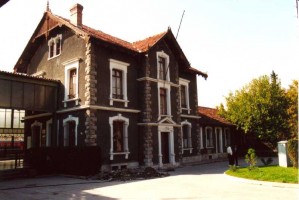
Ankara station master house, home of Mustapha Kemal Atatürk in 1920 / 1921. Photo JP Charrey | 
Entrance of the museum. Photo JP Charrey |
The Atatürk's Car
Access from the station: Atatürk's car is located along platform 1, behind the house of the Railway History museum. Simply walk along platform 1 on the Eskişehir side and you will not miss it.
This car was manufactured by Linke Hoffman / Breslau in 1935. It was used by Mustapha Kemal Atatürk until his death in 1938. Unfortunately only the outside of the car can be seen. The inside has all the facilities of a modern hotel suite: a bedroom, a desk, a bathroom. The car is equiped with special antenas in order to maintain constant telegraph communication.

Atatürk 's car in Ankara Station. Photo JP Charrey |
The Railway Art museum
Access from the station: before entering the station main building; go to the building on the left side, ring at the door; Don't hesitate do ring again and wait.
Opening hours and cost: the museum is open on weekdays, between 9h00 to 12h00 and 13h00 to 17h00. The entrance is free. again, do not hesitate to ring or knock.
Collection: This museum is more about railway techniques. It displays a collection of training models and drawings to explains how it works (bakes, steam engines, …). This museum has also a collection of paintings.
The outdoor locomotive museum
From the 1990's, there is an open air railway museum in Ankara with a collection of 10 steam locomotives. It used to be located across the track from the old railway station. However, this museum had to be moved to make way for the new high speed train station. In March 2014, the collection was transferred to a new location next to TCDD railway yard and maintenance facilities in Behiçbey.
Access
TCDD AÇIKHAVA TREN MÜZESİ, Gazi, Güvercinlik Yolu Cad., 06560 Yenimahalle/Ankara, Türkiye
Opening hours and cost
Collection
| Eng. Nbr | Axle | Manuf. Date | Manufacturer | Manuf. Nbr | Remark |
|---|---|---|---|---|---|
| 34061 | 1'C | 1933 | Henschel | 22365 | Similar to DRG24 |
| 44015 | D | 1912 | Ex CFOA, Ex KPEV G8 | ||
| 45035 | 1'D | 1932 | Nohab | 1866 | Similar to KPEV G8.2 |
| 45174 | 1'D | 1943 | Alco | 71076 | USRA S.160 |
| 46224 | 1'D1' | 1942 | Alco | 70088 | USATC S.200 "Middle East" Class |
| 55047 | E | 1924 | BMAG | 8351 | Ex CFOA Rly, Ex KPEV G10 |
| 56086 | 1'E | 1948 | Vulcan Foundry (GB) | 5689 | |
| 56375 | 1'E | 1948 | Vulcan Iron Works (USA) | 4823 | Skyliner |
| 56504 | 1'E | 1943 | Henschel | 27738 | DRG 52 "Kriegslok" |
| 57007 | 1'E1' | 1933 | Henschel | 22157 |
Ankara children railway engine KL46001 rejoined the museum in September 2015.
Other rolling stock on display
- A two axles light car from the 1890's.
- A two axles car from the 1920 / 30's.
- An electric coal loader, 2 axles
- A steam coal loader, 3 axles
Gallery
Ankara Museum, October 2004, Photo Graham Williams


